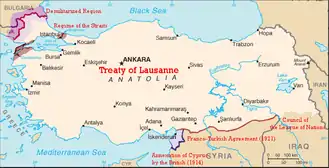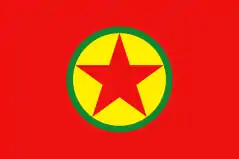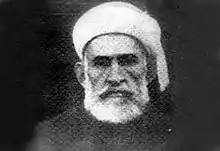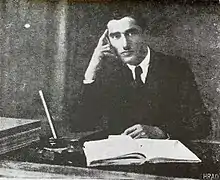Kurdish rebellions during World War I
During World War I, several Kurdish rebellions took place within the Ottoman Empire. These revolts were encouraged by the western allies, particularly Britain, who promised the Kurds an independent state.[1] The first Kurdish rebellion was launched in August 1914, before the Ottoman entry into World War I. From 1915 to 1916, further Kurdish rebellions took place in Botan, Dersim, and south of Kiğı. In summer 1917, rebellions took place in Botan, Dersim, and Kharput. The last rebellions took place in August 1917, which were also the only ones to receive allied military support, albeit limited.
| Kurdish rebellions during World War I | |||||||||
|---|---|---|---|---|---|---|---|---|---|
 Dersim Botan Nazımiye Mazght Pertek Perri Elazığ Kharput Mardin Diyarbekir Bitlis Kurdish rebellions during World War I (Turkey) | |||||||||
| |||||||||
| Belligerents | |||||||||
|
|
Limited support: | ||||||||
| Commanders and leaders | |||||||||
|
Among others | ||||||||
 |
In 1918, the Ottoman Empire was defeated in World War I. British wartime promises of an independent Kurdistan were included in the Treaty of Sèvres (1920), which assigned a small amount of territory for a planned Kurdish state, but these plans were abandoned with the Turkish nationalist victory in the Turkish War of Independence and the ensuing Treaty of Lausanne (1923). Kurdish rebellions in Turkey continued after 1923 and are still ongoing in the present day.
Background
Timeline
Initial revolt (1914)
The first Kurdish rebellion during World War I took place prior to the Ottoman entry into World War I. In August 1914, the nephew of the mayor of Dersim was killed by a member of the Ferhatuşağı tribe, and in response to Ottoman reprisals the Ferhatuşağı tribe rebelled. The Ferhatuşağı were joined by the Karaballı, Lower Abbas, Abbasuşağı and Koçuşağı tribes. The murder of the chieftain of the Ferhatuşağı tribe ended the rebellion.[2]
Uprising in Botan (1915–1916)
In spring 1915, a Kurdish revolt broke out in Botan.[3] The revolt drove out the Ottoman troops entirely and as a result, the locals would govern the region for over a year.[4]
Uprising in Dersim, Ottoman deportations (1916)
The Dersim uprising of 1916[5] was an Alevi Kurdish uprising[6] led by Ali Ağa[2] in the region of Dersim.[6] Its causes laid in the Kurdish fear that they would suffer the same fate as the Armenians, as well as the desire to remove the state control in Dersim.[7] This revolt has been encouraged by Russian emissaries, who had promised to local chieftains that Dersim would be given independence after Russian occupation.[8]
The uprising began in early March 1916.[8] Kurdish rebels occupied and destroyed the towns of Nazimiye, Mazght, Pertek, and Charsandjak,[6] and then marched towards the residence of the province governor (vali), Mamuretülaziz (modern day Elazığ).[9][6] As the Kurds advanced, they captured many weapons from Turkish soldiers.[10] Turkish officials in Mezere and Harput felt extremely threatened by the Kurdish revolt, since the Russians at the time occupied the area between Erzurum and Erzincan which adjoined Dersim to the north.[11] The Ottoman army would likely to be incapable of resisting a coordinated Kurdish-Russian advance on Harput,[11] leading the Muslim population of that settlement to make preparations to escape.[11]
In response to the Kurdish rebellion, Ottoman authorities launched an operation to clear Dersim from Kurdish rebels on 1 April.[8] Involved in this operation was the Ottoman 13th division, led by Galatalı Şevket Bey.[11] This division included a contingent of troops led by Hasan Khayri Bey,[5] as well as Shafi’i Kurds.[6] On the day following the start of the operation, Kurdish rebels launched an unsuccessful counterattack on Pertek.[8] Kurdish rebels were defeated at Kayacı, Mazgirt (13 April) and Şimaligarbî (16 April).[8] By 16 April, the rebels had been reduced to an area between Nazimiye and the Ohi stream.[8] On 18 April, after defeating 500 rebels in the area, Ottoman troops looted Kavaktepe and the surrounding villages.[8] The next day, they burned down the village of Lemit.[8] As Ottoman troops advanced, they clashed with Kurds at Şeyhin, Kopik (22 April), Gökerik Hill, Sinevartaşı (23 April),[8] and Zelbaba Hill (28 April).[8]
On 2 May, the Kurdish rebels surrendered.[8] The operation had concluded with the defeat of the rebels, who had suffered heavy casualties.[10] With the situation now having come under Ottoman control, the preparations of the Muslim civilians of Harput to escape had been rendered obsolete.[11] After the defeat of the uprising, entire populations of the responsible tribes were deported from Dersim.[9]
Kurds threaten the Ottoman rear (1916)

By late 1916, the Ottomans had suffered severe defeats at the hands of the Russians, having suffered a particularly severe defeat at Bingöl. This led the Kurds to once again rise up against Ottoman authorities. Ottoman convoys in Dersim were attacked and isolated units slaughtered. From September to October 1916, Kurdish rebel efforts turned the situation of the Ottoman rear south of Kiğı into one of "insecurity and disorder".[12]
In October, the Kurdish rebellion, alongside other factors, led Ottoman general Ahmed Izzet Pasha to withdraw troops from the front, which then suppressed the rebellion.[13]
Uprisings in Botan, Dersim, and Kharput (Summer 1917)
In summer 1917, Kurdish rebellions took place in Botan, Dersim, and Kharput.[3]
Last rebellions (August 1917)
In early August 1917, Kurdish rebellions took place in Mardin and Diyarbekir,[14] followed by Bitlis.[3] While the other Kurdish uprisings received no military support by the Allies of World War I, the uprisings of August 1917 received limited Russian support.[3]
Aftermath
Ottomans defeated in World War I (1918)
Despite victories against Kurdish rebels, the Ottoman Empire suffered reverses elsewhere, being defeated at Baghdad (March 1917), Jerusalem (November-December 1917), Transjordan, Megiddo, (September 1918) and Damascus (September-October 1918), before the signing the Armistice of Mudros on 30 October 1918. This concluded their involvement in World War I, and set the stage for the Kurds to follow up on wartime promises of independence from the western allies, particularly Britain.[1]
Kurds gain concessions (1919-1920)

The Kurds submitted their claim for independence to the Paris Peace Conference in 1919.[15] According to the Treaty of Sèvres, the Kurdistan region, including Mosul Province, was scheduled to have a referendum to decide its fate.
There was no general agreement among Kurds on what the borders of Kurdistan should be because of the disparity between the areas of Kurdish settlement and the political and administrative boundaries of the region.[16] The outlines of Kurdistan as an entity had been proposed in 1919 by Şerif Pasha, who represented the Society for the Elevation of Kurdistan (Kürdistan Teali Cemiyeti) at the Paris Peace Conference. He defined the region's boundaries as follows:
The frontiers of Turkish Kurdistan, from an ethnographical point of view, begin in the north at Ziven, on the Caucasian frontier, and continue westwards to Erzurum, Erzincan, Kemah, Arapgir, Besni and Divick (Divrik?); in the south they follow the line from Harran, Sinjar Mountains, Tel Asfar, Erbil, Süleymaniye, Akk-el-man, Sinne; in the east, Ravandiz, Başkale, Vezirkale, that is to say the frontier of Persia as far as Mount Ararat.[17]
That caused controversy among other Kurdish nationalists, as it excluded the Van Region (possibly as a sop to Armenian claims to that region). Emin Ali Bedir Khan proposed an alternative map that included Van and an outlet to the sea via what is now Turkey's Hatay Province.[18] Amid a joint declaration by Kurdish and Armenian delegations, Kurdish claims concerning Erzurum vilayet and Sassoun (Sason) were dropped, but arguments for sovereignty over Ağrı and Muş remained.[19]
Neither proposal was endorsed by the treaty of Sèvres, which outlined a truncated Kurdistan on what is now Turkish territory (leaving out the Kurds of Iran, British-controlled Iraq and French-controlled Syria).[20]
Koçgiri rebellion (1921)
The Turkish War of Independence (19 May 1919 – 24 July 1923) was fought between the Turkish National Movement and the Allied powers—namely Greece in the West, Armenia on the East, France on the South, royalists and the separatists in various cities, and the United Kingdom and Italy in Constantinople (now Istanbul)—after parts of the Ottoman Empire were occupied and partitioned following the Ottomans' defeat in World War I.[21][22][23]
During this war, Kurdish rebels fought against the Ankara government in the Koçgiri rebellion. After the Treaty of Sèvres was signed the Kurds began to feel more trustful that they were able to reach at least some sort of an autonomous government for themselves. Abdulkadir Ubeydullah, the son of Sheikh Ubeydullah and the president of the SAK,[24] supported the idea of a Kurdish autonomy within Turkey. But Nuri Dersimi and Mustafa Pasha wanted more than autonomy, they wanted to establish an independent Kurdistan according to article 64 of the treaty.[25] Mustafa Kemal followed up on the events in the Dersim area and as it came to his knowledge that some of the Kurds were pursuing autonomy in line with the fourteen points announced by US president Woodrow Wilson, he answered that the plan of Wilson was worthless for the peoples in the eastern provinces and they should rather follow his Turkish nationalist movement.[25] The rebellion began in the overwhelmingly militant Koçgiri region in eastern present-day Sivas Province in February 1921. The rebels were crushed by June 17, 1921.[26]
Concessions abandoned (1923)

After Turkish nationalist victories in the Turkish–Armenian, Franco-Turkish and Greco-Turkish fronts (often referred to as the Eastern Front, the Southern Front, and the Western Front of the Turkish War of Independence, respectively), the Treaty of Sèvres was abandoned and new treaties were signed. The Treaty of Lausanne (1923) failed to mention the Kurds.[1][15]
After Lausanne (1923-present)
Kurdish rebellions in Turkey continued after the Treaty of Lausanne. In the 1920s and 1930s, there were the Beytussebab rebellion (1924), Sheikh Said rebellion (1925), Ararat rebellion (1927-1930), and the Dersim Rebellion (1937-1938).
The Turkish Constitution of 1924 prohibited the use of Kurdish in public places, and a law was issued which enabled the expropriation of the Kurdish landowners and the delivery of the land to Turkish speaking people.[27] From 1927 on, a General Inspector ruled large Kurdish areas with the implementation of emergency decrees and martial law. The areas around Hakkari, Mardin, Siirt, Urfa, Van, Elaziğ and Diyarbakır were under the his rule until 1952,[28] when the government of the Democratic Party brought a new approach towards the Kurds and closed the General Inspectorates.[29]

During the relatively open government of the 1950s, Kurds gained political office and started working within the framework of the Turkish Republic to further their interests but this move towards integration was halted with the 1960 Turkish coup d'état.[30] The 1970s saw an evolution in Kurdish nationalism as Marxist political thought influenced a new generation of Kurdish nationalists opposed to the local feudal authorities who had been a traditional source of opposition to authority, eventually they would form the PKK, or Kurdistan Workers Party - a Kurdish militant organization which has waged an armed struggle against the Turkish state for cultural and political rights and self-determination for the Kurds. The PKK is designated as a terrorist organization by Turkey.[31][32]
See also
- Dersim uprisings
References
- Armstrong, Mick (28 October 2019). "The Kurdish tragedy". redflag.org.au. Archived from the original on 17 March 2020. Retrieved 2020-05-04.
- Yılmazçelik, İbrahim. "Dersim Sancağının Kurulmasından Sonra Karşılaşılan Güçlükler ve Dersim Sancağı ile İlgili Bu Dönemde Yazılan Raporlar (1875-1918)" (PDF). dergiler.ankara.edu.tr (in Turkish). p. 186.
- Eskander, Saad. "Britain's Policy Towards The Kurdish Question, 1915-1923" (PDF). etheses.lse.ac.uk. p. 45.
- Aḥmad, Kamāl Muẓhar (1994-01-01). Kurdistan During the First World War. Saqi Books. p. 122. ISBN 978-0-86356-084-2.
- Küçük, Hülya (2002). The Role of the Bektās̲h̲īs in Turkey's National Struggle. BRILL. p. 216. ISBN 9789004124431.
- Kieser, Hans-Lukas (2002). "The Alevis' Ambivalent Encounter With Modernity. Islam, Reform and Ethnopolitics In Turkey (19th-20th cc.)" (PDF). pdfs.semanticscholar.org. University of Zurich: 9. S2CID 26294288.
- Bloxham, Donald (2005). The Great Game of Genocide: Imperialism, Nationalism, and the Destruction of the Ottoman Armenians. Oxford University Press. pp. 108. ISBN 978-0-19-927356-0.
- Ozkok, Burhan (1937). Osmanlilar Devrinde Dersim Isyanlari (in Turkish). Askeri Matbaa.
- Kieser, Hans-Lukas. Muslim heterodoxy and protestant utopia. The interactions between Alevis and missionaries in Ottoman Anatolia. p. 105.
- Kaya, Yakup (2016). "Osmanlı Devleti'nden Türkiye Cumhuriyeti'ne Geçiş Sürecinde Dersim Sorunu". itobiad.com (in Turkish).
- White, Paul Joseph; Jongerden, Joost (2003). Turkey's Alevi Enigma: A Comprehensive Overview. BRILL. p. 183. ISBN 9789004125384.
- Allen, William Edward David; Muratoff, Paul (2011-02-17). Caucasian Battlefields: A History of the Wars on the Turco-Caucasian Border 1828-1921. Cambridge University Press. p. 438. ISBN 978-1-108-01335-2.
- Erickson, Edward J. (2001). Ordered to Die: A History of the Ottoman Army in the First World War. Greenwood Publishing Group. p. 137. ISBN 978-0-313-31516-9.
- Aḥmad, Kamāl Muẓhar (1994-01-01). Kurdistan During the First World War. Saqi Books. p. 123. ISBN 978-0-86356-084-2.
- Arin, Kubilay Yado, "Turkey and the Kurds – From War to Reconciliation?" UC Berkeley Center for Right Wing Studies Working Paper Series, 26 March 2015.
- Hakan Özoğlu, Kurdish Notables and the Ottoman State: Evolving Identities, Competing Loyalties, and Shifting Boundaries p. 38. SUNY Press, 2004
- Şerif Pasha, Memorandum on the Claims of the Kurd People, 1919
- Hakan Özoğlu, ibid p. 40
- M. Kalman, Batı Ermenistan ve Jenosid p. 185, Istanbul, 1994.
- Arin, Kubilay Yado, Turkey and the Kurds – From War to Reconciliation? UC Berkeley Center for Right Wing Studies Working Paper Series, March 26, 2015.
- "Turkey, Mustafa Kemal and the Turkish War of Independence, 1919–23". Encyclopædia Britannica. 2007. Retrieved 29 October 2007.
- "Turkish War of Independence". Microsoft Encarta Online Encyclopedia 2007. 2007. Archived from the original on 15 May 2008. Retrieved 29 October 2007.
- "Turkey, Section: Occupation and War of Independence". History.com Encyclopedia. 2007. Archived from the original on 24 October 2007. Retrieved 29 October 2007.
- Özoĝlu, Hakan (2004-02-12). Kurdish Notables and the Ottoman State: Evolving Identities, Competing Loyalties, and Shifting Boundaries. SUNY Press. pp. 88–91. ISBN 978-0-7914-5993-5.CS1 maint: date and year (link)
- Olson, Robert W. (1989). The emergence of Kurdish nationalism and the Sheikh Said Rebellion, 1880-1925. University of Texas Press. pp. 28–29. ISBN 978-0-292-77619-7.
- Ergün Aybars, İstiklâl Mahkemeleri, Bilgi Yayınevi, 1975, p. 34. (in Turkish)
- Olson, Robert (1989). The Emergence of Kurdish Nationalism and the Sheikh Said Rebellion, 1880–1925. University of Texas Press. p. 91. ISBN 0292776195.
- Jongerden, Joost (2007-05-28). The Settlement Issue in Turkey and the Kurds: An Analysis of Spatial Policies, Modernity and War. BRILL. p. 53. ISBN 978-90-474-2011-8.
- Bozarslan, Hamit (2008-04-17). Faroqhi, Suraiya; Kasaba, Reşat; Kunt, I. Metin; Fleet, Kate (eds.). The Cambridge History of Turkey. Cambridge University Press. p. 340. ISBN 978-0-521-62096-3.
- Laçiner, Bal; Bal, Ihsan (2004). "The Ideological And Historical Roots Of Kurdist Movements In Turkey: Ethnicity Demography, Politics". Nationalism and Ethnic Politics. 10 (3): 473–504. doi:10.1080/13537110490518282. S2CID 144607707. Archived from the original on 11 October 2007. Retrieved 19 October 2007.
- "Turkey spy agency denies role in Paris Kurds murder, launches probe". Radio France Internationale. 16 January 2014. Retrieved 5 February 2014.
- "Rewards for Justice - Wanted for Terrorism - Cemil Bayik". Retrieved 16 December 2019.
Further reading
Aḥmad, Kamāl Muẓhar (1994-01-01). Kurdistan During the First World War. Saqi Books. ISBN 9780863560842.

